Nvidia GeForce GTX 1070 Review
Is Nvidia’s new $380 graphics card really more powerful than a $1,000 Titan X?
Update: Click here to figure out which graphics card is right for you.
Nvidia’s new leading GPU--the GeForce GTX 1080--is a powerful graphics card that’s a great value. Even though it’s a fantastic deal, the $599 price tag still makes it prohibitively expensive.
The GeForce GTX 1070 lives up to the hype.
That’s why many budget-conscious enthusiasts have been waiting for reviews of the GeForce GTX 1070. Starting at a more attainable $379, Nvidia claims that the card is faster than the $1,000 GeForce GTX Titan X. While that may sound too good to be true, the GeForce GTX 1070 lives up to the hype.

Design
While you’ll see the GTX 1070 start out at $379, Nvidia once again sent me its more expensive Founders Edition version of the card, which costs $449. The added cost won’t get you a higher-quality binned GPU that will overclock better, which is what many were thinking. Rather, Nvidia says the price premium for the Founders Edition is merely for the high-quality materials and design craftsmanship.

The GTX 1070 uses the same 4.3x10.5-inch chassis as its more expensive GTX 1080 brother. This means you get the same angular die-cast aluminum enclosure, radial blower fan which exhausts heat outside chassis (which is good for compact Mini-ITX systems), three copper heatpipes for cooling, and a low-profile removable backplate.
One small issue I noticed while testing my particular unit is that its fan produces a slight, almost rattle-like noise under load. It’s not a major issue, but I didn’t hear it with the GTX 1080. Your mileage may vary. In terms of temperatures, the 1070 carries a 94 degree Celsius thermal threshold.

Features
Because the GTX 1070 is based off of Nvidia’s Pascal micro-architecture, it supports the same GPU features that were introduced with the GTX 1080. This includes graphical bells and whistles such as Ansel, VRWorks Audio, Simultaneous Multi-Projection, HDR, Fast Sync, and GPU Boost 3.0. You can read more about these features in my GeForce GTX 1080 review.
Specs
Based off of GP104, the GTX 1070 carries a lot of similarities to the GTX 1080. Both cards enjoy the same bandwidth reduction, preemption, and memory compression techniques that Pascal brings to the table, which makes it Nvidia’s most efficient architecture to date. The GTX 1070 is also built on TSMC’s new 16nm FinFET production process, which allows the card’s core and boost clocks to run really high. They’re not quite as high as the GTX 1080, but with a base core clock of 1506MHz and a boost clock of 1683MHz, it isn’t too far behind. Both the 1080 and 1070 tower over the frequencies set by Nvidia’s existing Maxwell-based lineup. For instance, the $1K Titan X carries a base clock of 1000Mhz (51 percent lower than the 1070) and a boost clock of 1075MHz (57 percent lower than the 1070). The GTX 1070 also features the same 256-bit memory bus width, 64 Render Output Units (ROPs), and 7.2 billion transistor count as the GTX 1080.
Spec Chart
| GTX 1070 | GTX 1080 | GTX Titan X | GTX 980 Ti | GTX 980 | |
| CUDA Cores | 1920 | 2560 | 3072 | 2816 | 2048 |
| Texture Units | 120 | 160 | 192 | 176 | 128 |
| ROPs | 64 | 64 | 96 | 96 | 64 |
| Core Clock | 1506MHz | 1607MHz | 1000MHz | 1000MHz | 1126MHz |
| Boost Clock | 1683MHz | 1733MHz | 1075MHz | 1075MHz | 1216MHz |
| Memory Clock | 8GHz GDDR5 | 10GHz GDDR5X | 7GHz GDDR5 | 7GHz GDDR5 | 7GHz GDDR5 |
| Memory Bus Width | 256-bit | 256-bit | 384-bit | 384-bit | 256-bit |
| VRAM | 8GB | 8GB | 12GB | 6GB | 4GB |
| TDP | 150W | 180W | 250W | 250W | 165W |
| GPU | GP104 | GP104 | GM200 | GM200 | GM204 |
| Architecture | Pascal | Pascal | Maxwell | Maxwell | Maxwell |
| Transistor Count | 7.2 billion | 7.2 billion | 8 billion | 8 billion | 5.2 billion |
| Manufacturing Process | 16nm FinFET | 16nm FinFET | TSMC 28nm | TSMC 28nm | TSMC 28nm |
| Launch Date | 6/10/2016 | 5/27/2016 | 3/17/2015 | 6/1/2015 | 9/18/2014 |
| Launch Price | $379/$449 | $599/$699 | $999 | $649 | $549 |
This isn’t to say the 1070 is a carbon copy of the 1080, however. With it costing $220 less, you should expect some concessions. The 1070 features 640 fewer CUDA cores and 40 less texture units compared to the GTX 1080. While it also features a healthy 8GB serving of video RAM, it does not use the faster 10GHz GDDR5X frame buffer. To assume that it’s getting the short end of the VRAM stick here wouldn’t entirely be fair, however. While the 1070 does use the more traditional GDDR5 VRAM, which has been in production since 2008, it carries a very speedy 8GHz frequency, which is 1GHz faster than the frame buffer of all of Nvidia’s 900-series cards. This makes it the fastest traditional GDDR5 video memory on the market.

The GTX 1070 uses an eight-pin power connector like the GTX 1080, but it’s 30 watts less power-hungry with a 150-watt TDP. This is very power-efficient when you compare it to the 250-watt Titan X, which it performs most similarly to.
Benchmarks
To provide you with a wide breadth of comparative data, I’m using the same suite of benchmarks from my GTX 1080 review, which covers the gamut of real and synthetic tests across 1080p, 1440p, 4K, and VR using the GTX 1080, 980, and 980 SLI. And since Nvidia has made claims that the 1070 is as fast as the Titan X, I’ve tracked one down and added it as a focal point of comparison.
I’m using the same system to test all the graphics cards, which is a PC equipped with Intel’s six-core 5930K, coupled with 16GB of DDR4 RAM. Because all the cards tested here are high-end, to properly push each, their benchmarks are set to their respective max settings.
Also, since my GTX 1080 review, a lot of readers asked me to add benchmarks for some newer titles, such as Overwatch, Rise of the Tomb Raider, The Witcher 3, and more. An issue here is that some of these games don’t feature in-game benchmarks and using FRAPS to manually capture frame rate data while gaming can cause inconsistent results due to the variance of player actions. This means you could get different numbers with different runs, even using the same GPU. Regardless, I wanted to add some of these newer games to the mix; not to provide comparative data between cards, but to at least give you a gauge of how the 1070 might be able to tackle them across 1080p, 1440p, and 4K resolutions. This data will be under the “experiential segment” of my benchmarks.
1080p Benchmarks
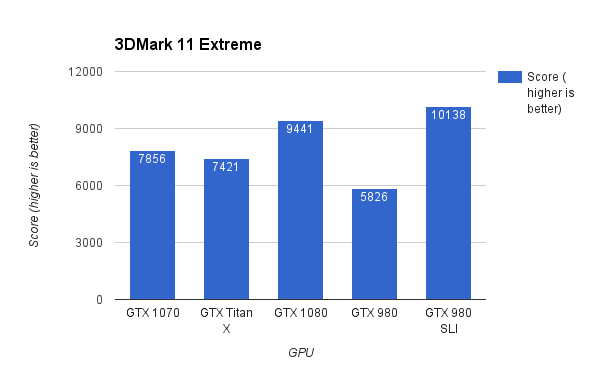
3DMark 11 is a synthetic graphics benchmark which pushes DirectX 11 performance. I ran it under the extreme preset, which renders multiple scenes at 1080p. Right out of the gate, you can see that the that GTX 1070 is six percent faster than the Titan X here.
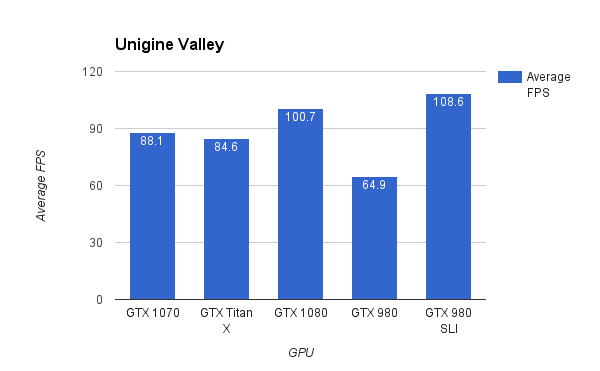
Unigine Valley is another synthetic graphics benchmark. Both the GTX 1070 and Titan X are able to generate frames in the 80s here, but with a four percent lead, the 1070 is able to once again outperform the more expensive Maxwell-based card. It’s also worth pointing out the huge 36 percent advantage the GTX 1070 enjoys over the GTX 980, which was a $500 graphics card just a few months ago.

The Titan X outperforms the 1070 by just a hair in BioShock Infinite. I’m talking a 141 FPS average vs. 142 FPS average here. It’s close enough to be within the margin of error, but still, a win's a win and *spoiler alert* the Titan X is going to need all the help it’s going to get. Another point of interest to look at here is the 12 percent gap between the GTX 1070 and the GTX 1080, which represents the smallest delta the two cards will experience between each other in my tests.
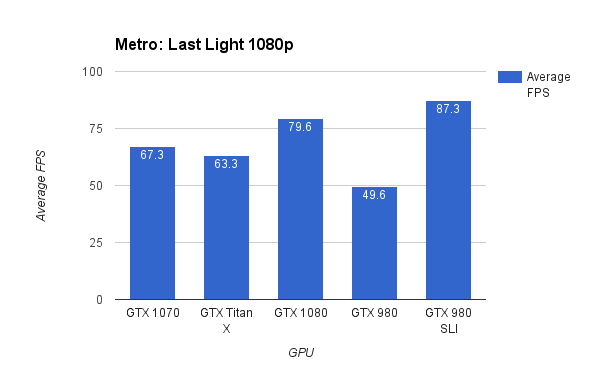
Metro Last Light is the most demanding graphical benchmark I’ve got here. With tons of lighting and physics effects, it can bring the mightiest of GPUs to their knees. Both the GTX 1070 and Titan X score above 60FPS average here, however. The 1070 does notch a six percent win by scoring in the upper 60s, whereas the Titan X scores in the lower half.

Shadow of Mordor represents an interesting battle between the GTX 1070 and the Titan X. Because the PC version of the game uses an HD texture pack, it loves VRAM. So, I was curious to see if the Titan X’s larger 12GB frame buffer would be able to give it the edge here or if the 1070’s smaller, but faster 8GB frame buffer would be enough. It looks like at 1080p, speed beats size, notching the GTX 1070 the win by nine percent.

With a really high 137.3 average FPS, the 1070 is able to enjoy a five percent lead over the Titan X here.
1080p Conclusion
With the exception of the BioShock Infinite benchmark, which was razor thin, the GTX 1070 was able to consistently beat the Titan X at 1080p. Regardless, both the Titan X and GTX 1070 are overkill at 1080p, unless you’re looking to take advantage of a super high refresh rate monitor.
1440p Benchmarks

While the Titan X was able to edge out the 1070 by a single percent at 1080p, the tables have turned with the 1070 getting the one percent advantage at 1440p. Both are still around 100 average FPS, however, so you’d be hard-pressed to tell the difference.

This is the first time the 1070 dips below 60FPS in my real-world benchmarks, but that’s the graphically demanding Last Light test for you. While both the 1070 and Titan X managed to garner above 60FPS average at 1080p, both drop all the way down to the high 30s at 1440p, which still meets the threshold of being playable. The 1070 does carry a five percent advantage over the Titan X, however, and while that’s not huge, when you start to dip into the 30s, every little bit helps.
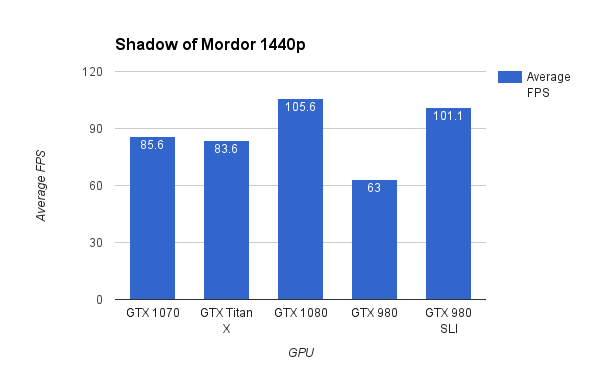
With a two percent advantage, the GTX 1070 once again pulls ahead in Shadow of Mordor. With both cards running the game in the 80 average FPS range, it suggests both cards will be able to handle the game at 4K, at least to some degree.
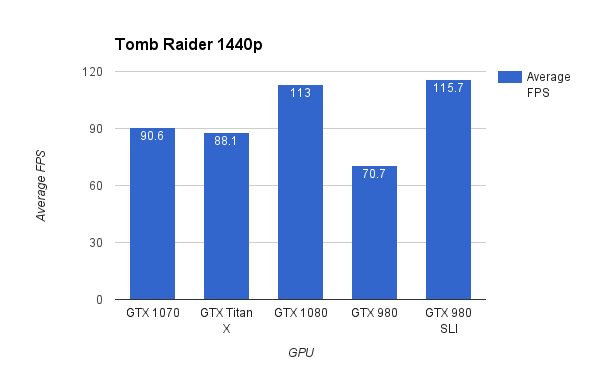
Tomb Raider: With a three percent lead, the 1070 just about cracks 90 average FPS, but the Titan X falls short of this threshold.
1440p Conclusion
While the GTX 1070 is overkill for 1080p gaming, it makes good sense at 1440p. You’ll be able to max out just about every single game here, even the most taxing games like Metro with above 30 average FPS. You’ll also get plenty of mileage if you opt for a high refresh rate UHD monitor.
4K Benchmarks

The GTX 1070 maintains its one percent lead over the Titan X in BioShock Infinite. Really, though, across all three of my BioShock Infinite runs, it’s pretty much a draw across the board. The 2160p resolution does manage to bring BioShock Infinite down below 60fps, however, which suggest you’ll have to drop some graphical settings down a bit if you want to game above 60FPS.
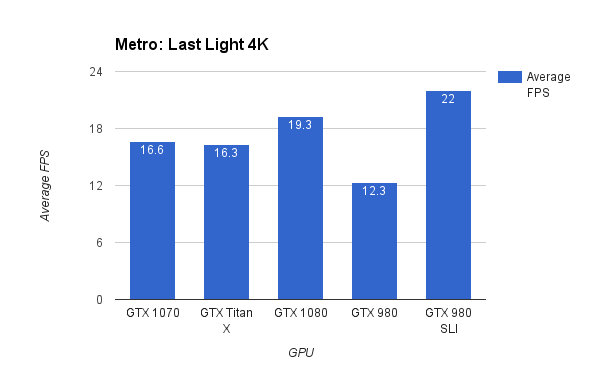
The GTX 1070 is two percent faster than the Titan X here, but both cards end up averaging around 16FPS on the ultra-demanding benchmark, which is unplayable on both setups. As a matter of fact, the game is unplayable across the board here on all of my configurations. Even the dual 980s, which proved to be the strongest of the pack, only managed to ratchet 22 average FPS.

The GTX 1070 is able to enjoy its biggest lead over the Titan X out of all of my tests with a nine percent advantage here. While Shadow of Mordor loves VRAM and the Titan X has 4GB more VRAM than the 1070, it looks like the 1070’s 8GB allotment isn’t a bottleneck at 4K and its faster frequencies are able to give it the win. Shadow of Mordor also represents the biggest lead the 1070 enjoys over the GTX 980, with a big 39 percent gap. It looks like the GTX 980’s relatively small 4GB framebuffer was a bottleneck here at 4K.
4K Conclusion: The battle for 4K was going to be the most interesting fight between the GTX 1070 and the Titan X. At this high of a resolution, VRAM can matter a lot, and with the Titan X having a massive 12GB framebuffer, I wasn’t sure if it was going to prove advantageous for the Titan X at this resolution. Considering the 1070 won in all the benchmarks, however, this suggests that 8GB of VRAM isn’t a bottleneck for 2160p, which means core and memory speeds matter more than sheer VRAM size.
But is the 1070 a 4K card? Aside from the most graphically-demanding games/poorly optimized ports, it will be able to max out the majority of games with at least 30FPS average.
VR Test

There aren’t that many virtual reality benchmarks available, unfortunately, but there is Valve’s SteamVR Performance Test. It uses Valve’s Aperture Science VR demo as the backdrop and at the end of the test, tells you how many total frames your computer was able to generate throughout the benchmark. Because low frame rates can cause some people to become motion sick in VR, the higher number of frames indicates a better score.
In the SteamVR demo, the GTX 1070 was able to produce 10729 frames, which is six percent better than the Titan X. While it falls short of the GTX 1080, which is the best card for VR at the moment, it is able to enjoy a huge 36 percent lead over the GTX 980, which is a good card for VR in its own right.
Experiential Tests
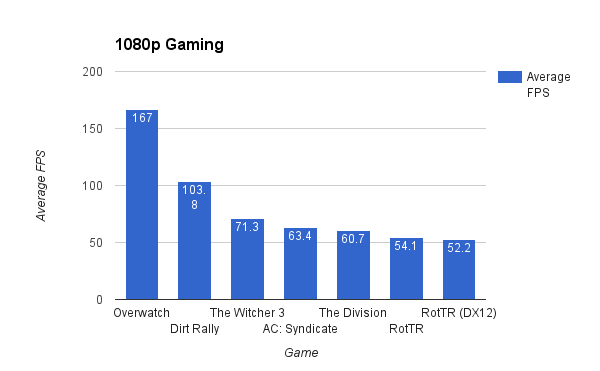
The GTX 1070 is able play every single new game at 1080p with smooth, playable framerates. The card was able to render Overwatch with a 167 average FPS when I played a round of control point with it. Unless you have a super high refresh rate monitor, the GTX 1070 is overkill for 1080p gaming here. The only game in my suite of tests to take the 1070 below 60 average FPS is Rise of the Tomb Raider, where it garnered an average FPS in the 50s. It’s also worth mentioning that RotTR is also one of the most graphically demanding games out today. The game is also one of the few titles which currently offers a DirectX 12 mode. Interestingly, performance took a small two-frame performance hit here when I enabled it.
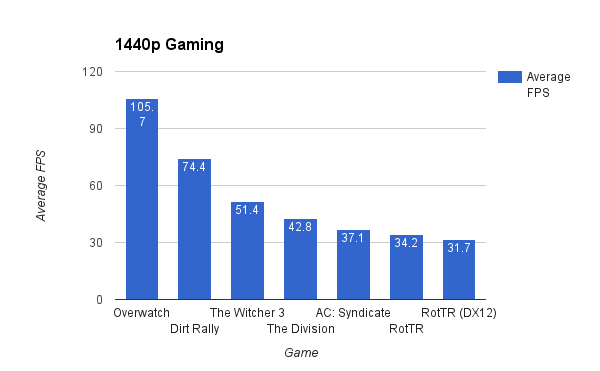
While the GTX 1070 is overkill for 1080p gaming, it makes good sense at 1440p. You’ll be able to max out just about every single game here.
My experiential tests at 1440p once again show that the GTX 1070 is a great card for ultra-HD (UHD) gaming. It’s able to play every single game here with above 30FPS averages, though the very graphically-demanding Rise of the Tomb Raider does make it close, especially under DX12.

Here is where things get dicier for the GTX 1070. Games like Overwatch and Dirt Rally are perfectly playable at 4K. Playing The Witcher 3 or anything else more graphically-taxing, however, and you’ll have to turn down some settings if you want above 30 average FPS experiences.
Overclocking
Because properly overclocking and benchmarking a GPU can take hours, if not days to do properly, you’ll have to wait for a more in-depth article on how well the GeForce GTX 1070 overclocks in the near future. In the meantime, I did some preliminary tests and managed to get the card running stable with a GPU core offset of 150MHz and a memory offset of 500MHz. This isn’t bad and puts it in the ballpark of the GTX 1080’s overclockability.
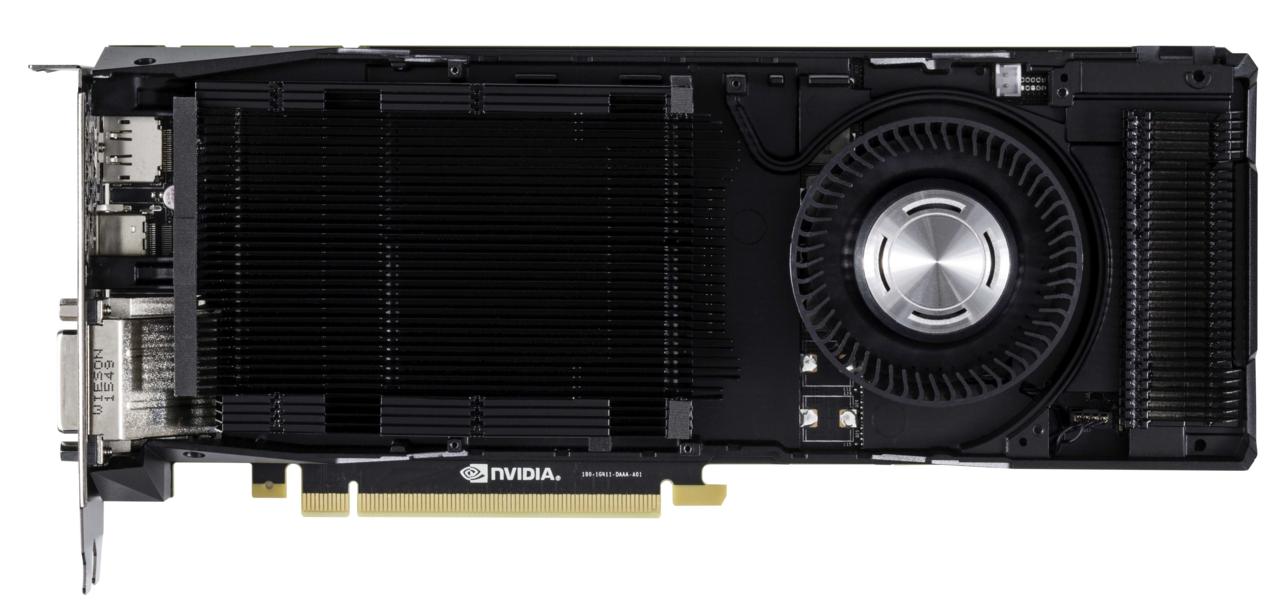
Conclusion
If you were tallying the wins between the GTX 1070 and the Titan X in my suite of benchmarks, then you’ll know that the 1070 beat the Titan X in all of the benchmarks with the exception of one test, where it was just one percent behind. Not only is this within the statistical margin of error, but it was a test done at 1080p with both cards averaging over 140 FPS. Like the Titan X and GTX 1080 before it, the GTX 1070 is overkill for 1080p gaming, unless you’re running a really high refresh rate monitor. Also like the GTX 1080, it will be able to max out all 1440p games with playable framerates as well, though it won’t achieve above 60 average FPS for the most taxing games. It’s also a viable card if you want to dip your feet into 4K, but, again, it won’t be able to max out the most graphically demanding games there.
When you compare it to the Titan X, it’s up to nine percent faster and up to 55 percent cheaper. That’s a crazy good deal.

With a 12-23 percent delta between it and the GTX 1080, the GTX 1070 certainly isn’t as fast as its big brother, but it also costs roughly 36 percent less. When you compare it to the Titan X, it’s up to nine percent faster and up to 55 percent cheaper. That’s a crazy good deal. Sure, the GTX 1070 makes some concessions against the GTX 1080, but, for the most part, it performs admirably where it counts.
Got a news tip or want to contact us directly? Email news@gamespot.com
Join the conversation